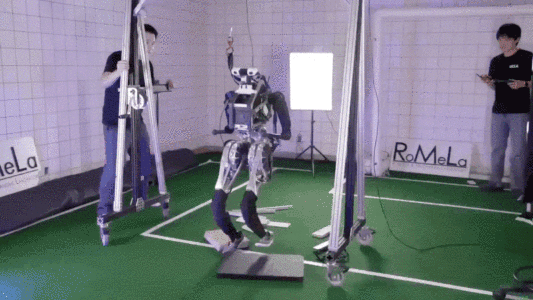According to Tech Xplore, mechanical engineers at the Samuelley School of Engineering (Samueli) at the University of California, Los Angeles (UCLA) have developed a full-scale humanoid robot. The robot, called ARTEMIS, will travel to Bordeaux, France, in July to compete in the soccer competition of the 2023 RoboCup.
This robot is essentially a general-purpose humanoid robot. The robot is 4 feet 8 inches (about 141.24 centimeters) tall and weighs 85 pounds (about 38.5 kilograms), and it can walk on rough and uneven ground while also running and jumping. ARTEMIS remains stable even under push or other disturbances.

▲Robot movement in the laboratory environment
According to researchers at UCLA, in lab tests, ARTEMIS can walk 2.1 meters per second, making it the fastest walking humanoid robot in the world. It is also believed to be the first humanoid robot designed by academia to run (here 2.1m/s is laboratory data, which is different from the speed of uploading by research institutions in video platforms). )
The robot's main innovation is that its actuators are specially designed, which play the role of human muscles, they are elastic, and can control the amount of force emitted, whereas most robots previously had stiff limbs and were difficult to process instructions flexibly.
Dennis Hong, a professor of mechanical and aerospace engineering and director of the Robotics and Mechanisms Laboratory at UCLA, said the actuator, which acts as human muscles, is key to maintaining good balance when the humanoid robot walks on uneven ground, and allows the robot to lift its feet off the ground when moving.
Another advancement in the robot is that ARTEMIS' actuators are powered by electricity, rather than hydraulics. Simply put, hydraulic control refers to the use of fluid pressure difference to drive movement, so it is noisy and also causes the risk of liquid leakage. The electric drive not only avoids the disadvantages of this method of hydraulic control, but more importantly, the efficiency of the electric drive is also higher.
ARTEMIS's ability to react and adapt to perceived things comes from its sensor and actuator systems. It has custom-designed force sensors on each foot to help the machine maintain its balance while moving. ARTEMIS ALSO HAS AN ORINENTATION UNIT ON ITS HEAD AND TWO CAMERAS THAT HELP IT PERCEIVE ITS SURROUNDINGS.
▲The robot perceives the surrounding environment
To make ARTEMIS stand out in the RoboWorld Cup soccer, the researchers have been taking the robot on regular walks on the campus of UCLA and testing it. Over the next few weeks, they will fully test the robot's running and soccer skills at UCLA's on-campus grounds. The researchers will also assess the robot's ability to move in uneven ground and stairs, as well as its ability to carry objects. The Robotics and Mechanisms Lab's Twitter account regularly shares information about robot test results and posts routes for its campus walks.
"We're excited to field test it at UCLA, and we see this as an opportunity to promote science, technology, engineering and math to a wider audience," said Denis Hong. ”
Recently, Taoyuanmin Zhu and Min Sung Ahn, Ph.D., in mechanical engineering at UCLA, developed ARTEMIS hardware and software systems, respectively. The Robotics and Mechanism Laboratory has been manufacturing humanoid robots for more than 20 years, and earlier robots have won the Robotics World Cup five times.
Conclusion: The new progress of humanoid robots, the power system has become a key breakthrough
ARTEMIS CONTRIBUTED NOT ONLY TO THE ROBOT'S ACTUATORS BEGIN TO FUNCTION LIKE HUMAN MUSCLES, BUT ALSO TO THE IMPROVED PERCEPTION. In the long-term use of "ontology-skills-intelligence" bottom-up research and development route of the idea, leg exercise ability is the first hurdle to overcome, ARTEMIS breaks through the previous robot stiff, insensitive weakness, has the same ability to move like a human, for the development of humanoid robots to point out the way, that is, constantly improve the power system has become its key breakthrough.
In addition, ARTEMIS' focus on perception will help humanoid robots "smarter", allowing humanoid robots to flexibly respond to various complex cross-scenario work modes, and truly help humans with related work.
Source: Tech Xplore